Abstract
In recent years, the route-planning problem has gained increased interest due to the development of intelligent transportation systems (ITSs) and increasing traffic congestion especially in urban areas. An independent route-planning strategy for each in-vehicle terminal improves its individual travel efficiency. However, individual optimal routes pursue the maximization of individual benefit and may contradict the global benefit, thereby reducing the overall transport efficiency of the road network. To improve traffic efficiency while considering the travel time of individual vehicles, we propose a new dynamic route-planning method by innovatively introducing a bidding mechanism in the connected vehicle scenario for the first time. First, a novel bidding-based dynamic route planning is proposed to formulate vehicle routing schemes for vehicles affected by congestion via the bidding process. Correspondingly, a bidding price incorporating individual and global travel times was designed to balance the travel benefits of both objectives. Then, in the bidding process, a new local search algorithm was designed to select the winning routing scheme set with the minimum bidding price. Finally, the proposed method was tested and validated through case studies of simulated and actual driving scenarios to demonstrate that the bidding mechanism would be conducive to improving the transport efficiency of road networks in large-scale traffic flow scenarios. This study positively contributes to the research and development of traffic management in ITSs.
1. Introduction
Intelligent transportation systems (ITSs) are an important part of the urban geo-information framework, and road traffic congestion has become an extensive problem in urban areas that hinders the operational efficiency of urban traffic systems and the intelligent application of urban geo-informatics. The urban road traffic congestion problem is caused by high population density, an excessive number of motor vehicles during peak hours, and an imbalance in the demand-supply in transportation networks [1]. Thus, massive road networks and traffic infrastructure are built in an attempt to alleviate this problem [2]. However, continuously building roads alone to greatly expand the road capacity has been reported to be ineffective, impractical, and expensive for long-term traffic congestion reduction [3]. In reality, there are various free road segments that do not produce positive effects when other road segments are congested [4,5]. Consequently, a reasonable route-guidance scheme for vehicles is a feasible option in building an effective traffic control management system and improving the service standard of urban geo-informatics.
In the past few decades, vehicle route planning has been extensively studied in the fields of traffic engineering and automation control for optimizing problems in transportation, distribution, and logistics. There are several classical route-planning algorithms that compute the shortest path between two locations in road networks, such as algorithms include the Dijkstra [6], A* search [7], Bellman-Ford [8], and bidirectional search [9] algorithms. Furthermore, various improved methods have also been proposed to handle other complex travel requirements, including improving the computing efficiency and reducing traffic congestion. For example, the route-planning efficiency of large-scale traffic flow in static road networks can be improved by improving the search efficiency using optimization techniques such as road hierarchies [10], road network partitioning [11], and batch search [12]. Nevertheless, real-world route planning is more than just identifying the shortest route length between two points in a static network; it also includes several dynamic parameters, such as traffic congestion levels, random incidents, and weather conditions among others. Furthermore, human travel is a dynamic process over a period of time, which means that the optimal route inevitably changes as travel progresses. Conventionally, planned routes are continuously adjusted to optimize travel routes dynamically within each discrete time step [13,14]. Therefore, it is essential for vehicles to adjust their planned routes adaptively to avoid traffic congestion.
The development of connected vehicles (CVs), which can communicate with each other and supply crucial information such as vehicle location, heading speed, traffic conditions, and distance, is a potential solution to the adaptive route-planning problem in large-scale traffic flow due to their distributed computing and independent decision-making abilities [15]. A well-known approach for coordinating multiple CVs is to design a distributed framework in which each CV acts as a powerful traffic information collector and computing node [16,17]. This can significantly reduce the computational burden on route planning centers [18]. Moreover, each CV can independently plan its own route according to local information from neighboring vehicles [15] using wireless communication and distributed computing technologies. Route-planning strategies with different travel demands, such as travel time [19,20], route stability [21], fuel consumption [22], security [23], and traveler habits [17], have been extensively studied in distributed frameworks.
These individual-oriented routing strategies pursue the maximum benefit of individual travelers, which usually contradicts the global traffic efficiency [24,25]. Although optimal routing schemes for individual vehicles can shorten their travel time, it is not conducive to alleviating the overall traffic congestion, leading to inefficiencies in the overall road network [26,27]. In a case study of Boston, USA, empirical analysis by Youn et al. indicated that individuals will waste approximately 30% of their travel time because of their personal routes [26], which could be up to twice the minimum travel time of the traffic system in particular cases [24]. Therefore, to reduce the overall travel time and alleviate traffic congestion, we propose a new bidding-mechanism-based route-planning method, which is introduced to plan vehicle routing schemes by coordinating with multiple road segment agents. The novelty of our study lies in that multiple agents jointly negotiate to formulate routing schemes through a bidding mechanism, which provides the possibility of alleviating traffic congestion and greatly improving the overall traffic efficiency of road networks. Through experiments in Wuhan, China, we demonstrate that the global travel time of routes planned by the proposed method is reduced by 32.71% on average. In addition, the computational burden of route planning that is distributed to CVs and road segment agents improve the overall computational efficiency.
The main contributions of this study can be summarized as follows:
- (1)
- To the best of our knowledge, we innovatively introduce for the first time a bidding mechanism to dynamically coordinate plan routing schemes for vehicles affected by congestion based on the road intersection planning center model. In this mechanism, the independent route-planning schemes of control centers in a centralized framework are transformed into a route-negotiation process of multiple CVs and road segment agents, resulting in a traffic efficiency improvement in the road network.
- (2)
- Individual and global vehicle travel times are considered simultaneously when determining bidding prices in the model, which balances the benefits of individual vehicles and global efficiency in route-planning processes. Thus, the proposed method can improve the overall traffic efficiency while avoiding congestion for individual vehicles.
- (3)
- A novel priority-set-based local search algorithm is proposed to address the combination assignment problem between large-scale traffic flow and road segments in the bidding-based route-replanning process. This algorithm improved the efficiency of route replanning by selecting a combination of winning schemes rather than a single one.
- (4)
- The remainder of this paper is organized as follows. Section 2 outlines the dynamic route-planning process. The proposed method for dynamic route planning according to the bidding mechanism is described in Section 3. Section 4 reports the methods and results of the simulation case experiments conducted to analyze the routing schemes and computational efficiency of the proposed method. Finally, Section 5 presents the discussion and conclusions of this study.
2. Dynamic Route-Planning Method Overview
Time discretization is a popular method for realizing dynamic route planning [13,14]. Replanning the routes of all vehicles within each time step to achieve optimal dynamic routes consumes considerable computing resources [13]. However, in an actual traffic scenario, only a few vehicles affected by congestion may require route replanning. In addition, there is no obvious difference in the vehicle routes on many unobstructed roads before and after replanning. Therefore, investing considerable computing time might not significantly reduce the travel cost of the entire transportation network. Thus, in the proposed method, only the driving route of vehicles that will be affected by congestion are dynamically replanned in advance; vehicles on unobstructed road segments would continue with their originally planned routing scheme to achieve a balance between the computational burden and transport efficiency of the road network.
The dynamic route-planning flow is shown in Figure 1, which consists of initial route generation, congestion judgment, and route replanning. First, vehicles plan their initial optimal route schemes Fori autonomously according to the initial traffic density. Then, vehicles will update their position based on the first-in-first-out (FIFO) formula within a single time step. Subsequently, road segments with evident traffic congestion are detected via the clustering method [28]. Finally, routing schemes are replanned in advance according to the bidding mechanism for vehicles that will be affected by congestion within each time step (see Section 3.1), while vehicles located on other uncongested road segments continue traveling along their planned routes. Vehicle location is continuously updated until all vehicles arrive at their destination.
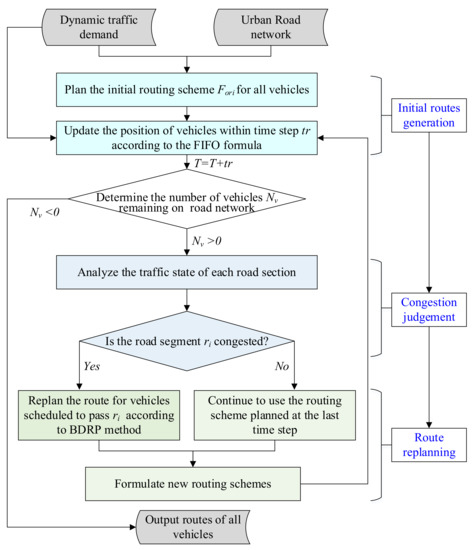
Figure 1.
Dynamic route-planning flow.
In simulation scenarios, the real-time vehicle position can be determined according to the traffic volume movement from road segment to road segment in each time step. The relationship between traffic flow and density conforms to a triangular or trapezoidal function, as shown in Figure 2. In the figure, denotes the traffic density, is the traffic density when roads are congested, represents traffic flow, is the saturation flow of the road segment, represents the free traffic flow speed, and is the back propagation speed in heavy traffic. Based on this relationship between traffic flow and density, the flow rate of road segments can be expressed as:

Figure 2.
Density-flow relationship of the traffic flow.
Thus, within time step , the traffic volume flowing to road segment from road segment is
where represents the traffic volume flowing into road segment within the time span , is the traffic flow rate flowing to road segment at time , is the traffic density of road segment at time , is the maximum flow rate flowing to road segment at time , and is the traffic density of road segment at time . Accordingly, road segment agents can obtain the inflow and outflow traffic volumes of each road segment. Thus, vehicle position is dynamically updated according to the FIFO formula during the route-replanning process.
3. Bidding-Based Dynamic Route-Planning (BDRP) Method
3.1. Bidding-Based Vehicle—Road Coordination Planning Method
In essence, vehicle route replanning can be considered as a combinatorial assignment problem in which multiple vehicles are allocated to multiple road segments at road intersections. Hence, a bidding-based vehicle–road coordination planning method is proposed to replicate the route of vehicles affected by congestion. First, the intersection where congested road segments are located is modeled as a virtual and relatively independent planning center (as shown in Figure 3a, intersection scenario A). The road segment agents within the planning centers negotiate the optimal routes for its vehicles internally affected by congestion. Then, an improved bidding mechanism is introduced to negotiate the assignment scheme of vehicle tasks. As a distributed negotiation framework, the bidding mechanism can be applied to the rapid allocation of large-scale tasks in dynamic scenarios. As shown in Figure 3a, the upstream road segments adjacent to a congested segment act as a tenderer, whereas the candidate road segment that vehicles may pass through acts as a bidder.
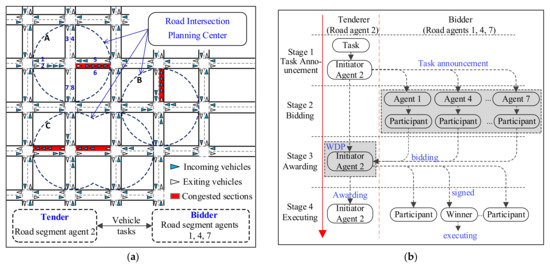
Figure 3.
Schematic of the bidding-based vehicle-road coordination planning. (a) road intersection planning center model; (b) four stages of vehicle-road bidding.
There are four stages in the vehicle–road negotiation process. First is the task announcement stage, in which the tenderer issues vehicle task announcements that contain task information, such as the vehicle’s location and destination, to the other candidate road segment agents within the intersection planning center. Second is the bidding stage, in which each candidate road segment agent calculates the routing schemes and bidding prices (travel time) for each vehicle task starting from the candidate road segment and submits these calculated information to the tenderer. Third is the awarding stage, in which the tenderer determines the globally optimal vehicle routing scheme using a winner bidder selection algorithm described in Section 3.2. Finally, in the task execution stage the tenderer confirms the schemes with the winning bidder and sends the vehicle allocation schemes to all candidate bidders.
For example, as shown in planning center A in Figure 3a, when road segment 6 is congested, the vehicles on road segment 2 that are scheduled to pass through road segment 6 are regarded as tasks to be assigned. The road segment agent 2 serves as a tenderer, and the passable road segment agents 1, 4, and 7 serve as bidders competing for vehicle tasks. They coordinate the allocation scheme of the vehicle tasks.
Assuming that is the set of vehicle tasks that requires a replan route, the set of road segment agents at the same intersection is denoted as . Meanwhile, is the set of communicable neighboring road agents of within , where is the number of road agents. The communicable neighboring resource set of is defined as the set of road agents that can communicate directly with and within the same intersection planning center. In addition, is the bidding vehicle replanning scheme from bidder , and is the corresponding bidding price. Finally, is the set of winning schemes for road agent and is the vehicle tasks included in , .
The vehicle replanning process presented in Algorithm 1 starts when the vehicle task set on road agent can no longer follow the original routes. First, ri publishes the bidding announcements to candidate bidders in (line1). Then, each bidder’s formulates the driving route for vehicles and determines their travel time (lines 3 and 4). After determining the vehicle tasks that they intend to bid for, then submits routing schemes and prices , which can be calculated using Equation (3), to (lines 5 and 6). Next, road agent selects the set of winning bidding schemes in accordance with the winning bidder determination algorithm presented in Algorithm 2 (line 8). The replanning scheme can be obtained when all vehicle tasks are completed (lines 9–11). However, there may be some remaining vehicles in whose routes have not been replanned (lines 9 and 12), due to the restrictions of the capability of road transport. Vehicles will then take the initiative to formulate the routing scheme when all road agents cannot provide better routes (lines 13 and 14). The final plan consists of and (line 15).
| Algorithm 1 Bidding-based coordination planning algorithm |
| Input: |
| Set of vehicle tasks that requires route replanning |
| Road agents in R that require allocating vehicle tasks |
| Set of neighboring road agents of ri available for bidding |
| Output: |
| Vehicle task replanning scheme |
| 1 Let be a tenderer who publishes a bidding announcement to candidate bidders in RNi |
| 2 For each bidder in do |
| 3 Obtain the destinations of vehicles |
| 4 Calculate optimal paths and travel time from bidder to destinations for vehicles |
| 5 Determine the vehicle task set for bidding according to their planned vehicle tasks |
| 6 Submit bidding task replanning scheme and bidding price |
| 7 End |
| 8 Determine the set of winning bidding scheme by calling Algorithm 2 |
| 9 |
| 10 If then |
| 11 Return the replanning scheme |
| 12 Else |
| 13 Each vehicle in selects its optimal path independently |
| 14 Generate replanning scheme according to these paths |
| 15 Return the replanning scheme |
| 16 End if |
Referring to the formulation proposed by Çolak et al. [29], the bidding price is defined as a linear combination of the time cost the vehicle will incur in (individual travel time) and the total time cost imposed on others (global travel time):
where denotes the set of road segments included in the candidate route of the kth vehicle when ri is bidding. represents the travel time observed on road r for vehicle flow . defines the adjustment parameter towards global travel benefit, ranging between 0 and 1. A planning scheme with chooses routes with respect to the global travel time. Conversely, a planning scheme with considers an individual travel time.
Urban traffic scenarios are extremely complex, and the travel time of vehicles on free and congested roads varies greatly. Thus, the speed-based impedance function (SIF) was used to estimate the actual travel time [30].
where indicates the average free traffic speed and represents the self-flow speed on free traffic roads. is the length of the free traffic road. and are two regression parameters that are consistent with the BPR function. represents the length of congested roads and is the speed of vehicles on congested roads with vehicle flow .
3.2. Winning Bidder Determination Algorithm
All bidders submit bidding schemes to the tenderer during the coordination planning process. It should be noted that vehicle routing schemes submitted by different bidders may contain the same vehicle tasks. Considering that each vehicle can only travel on one road segment, multiple bidding schemes may cause conflicts between vehicle tasks. Therefore, a tenderer will select a globally optimal vehicle routing scheme to avoid vehicle task conflicts based on the submitted schemes.
Therefore, we constructed an integer programming model, which is defined in Equation (5) to solve this winner determination problem (WDP). The objective of this model is to minimize the overall bidding price (travel time) of routing schemes.
The model solution can be expressed as a Boolean set in which = 1 means that bidding scheme is selected as the winning scheme and is the number of bidders. Thus, the objective function can be expressed as:
where is the bidding benefit of the kth bidder.
The constraints are identified as: (1) and (2) . The operation ⊕ is defined as: if , , and bidding scheme is in conflict with bidding scheme (i.e., ), then we have . Otherwise, . The second (2) constraint indicates that the two bidding schemes cannot be in conflict.
To determine winning bidding schemes, we proposed a priority-set-based local search (PLS) algorithm (Algorithm 2) that gradually approaches the optimal solution through multiple iterative searches. In each iteration, the algorithm finds the bidding scheme Bmin with the lowest price and adds it to candidate solution . Bidding schemes that conflict with are removed from candidate solution . In addition, a bidding scheme set that does not conflict with candidate solution is searched first in each iteration to improve the search efficiency. Moreover, the algorithm can reduce the possibility of falling into a local optimum by searching the bidding scheme within a fixed price interval (i.e., ) in each iteration.
Specifically, during each iteration, the PLS algorithm prioritized searching the set of non-conflicting bidding schemes . The bidding scheme with the smallest bidding price in was added to candidate solution (line 4). By contrast, if there is no scheme in , the algorithm updates candidate solution through the following steps. With a given probability , the algorithm first determines the minimal bidding price in the temporary search set (line 8). The bidding scheme set was selected from within the price interval ) (line 9). As shown in Equation (6), replacing the minimum value with the interval of the minimum value is beneficial for candidate solution in avoiding the local optimal trap. Moreover, a scheme was randomly selected from scheme set to add to candidate solution (lines 10 and 14).
Furthermore, the algorithm updates candidate solution through the conflict relationship between and (line 15). Finally, the best bidding scheme is updated if the total price of is smaller than that of (lines 17 and 18). At the end of each iteration, the priority search set PB is also updated according to the conflict relationship between and (line 20).
| Algorithm 2 Priority-set-based local search algorithm |
| Input: |
| S Set of bidding schemes submitted from all bidders |
| V Bidding price set |
| ρ Probability parameter within (0,1) |
| σ Bidding price interval parameter |
| Output: |
| Sbest Best vehicle task allocation scheme |
| 1 Initialize priority search schemes set = |
| 2 While changes in two adjacent iterations |
| 3 If then |
| 4 |
| 5 Else |
| 6 Temporary scheme set |
| 7 With probability do |
| 8 Determine the minimal price of bidding schemes in TemB |
| 9 Select bidding scheme set from within the floating price interval . |
| 10 Select scheme randomly from |
| 11 Otherwise |
| 12 Select t scheme randomly from |
| 13 Done |
| 14 |
| 15 Update : Remove bidding scheme that conflicts with from |
| 16 End if |
| 17 If the total price of is smaller than that of then |
| 18 |
| 19 End if |
| 20 Update PB according to the conflict relationship between and . |
| 21 End while |
| 22 Return |
4. Case Study
4.1. Simulation Case Experiment
To measure the performance and characteristics of various route-planning methods, we set up a simulated traffic scenario oriented to traffic diversion using the approbatory Nguyen network (Section 4.1.1). The network transport efficiency (Section 4.1.2) and road utilization rate (Section 4.1.3) of various routing schemes obtained by different planning methods were compared in this scenario, which was conducive to revealing the characteristics and applicability of the different planning methods.
4.1.1. Experimental Setting
In this experiment, the Nguyen road network was used to verify the effectiveness of the proposed BDRP method. The Nguyen network was originally proposed by Nguyen [31] as a classic traffic research case. Despite the road network being simplified, the Nguyen network retains the structural characteristics of an actual road network, including intersections, T-junctions, and two-way routes, among other. It is often used to simulate simple traffic scenarios to reveal the dynamic process of traffic flow without external interference. As shown in Figure 4, the Nguyen network consists of 13 nodes and 38 bidirectional road segments. In this experiment, the initial traffic demand was randomly set in each road segment; four nodes at the edge of the network were considered as travel destinations to simulate the distribution of real traffic flow. The simulation parameters are listed in Table 1.

Figure 4.
Nguyen network and parameters.

Table 1.
Parameter settings of the simulation experiment.
The following six route-planning methods, including three static route-planning methods and three dynamic route-planning methods, were used as comparison methods in this experiment. Static route-planning methods include the static shortest path method (SSP), the top-K shortest path method (TSP), and the logit model-based shortest path method (LSP). The SSP method plans routes for all vehicles according to the A* shortest path algorithm. Once routing schemes are determined, they will not be changed during the subsequent journey of vehicles [32]. To prevent road congestion caused by the shortest route, the TSP method selects one of the K optimal routes between the OD as a routing scheme based on a given probability after determining them [33,34]. However, in an actual travel scenario, there is usually a certain deviation between travelers’ perceived cost and the actual cost of the route. The LSP method, which assumes that this deviation is subject to the Gumbel distribution (an extreme value distribution), has been widely used in route planning [35].
Furthermore, three dynamic route-planning methods were included: a hierarchical dynamic route-planning method (HDP), time-optimization routing (TOR) method via modeling time mechanism, and dynamic shortest path (DSP) method. The HDP method calculates the shortest path by computing terminals in vehicles and divides the road hierarchy and routing area to improve calculation efficiency [36]. The TOR method calculates the vehicle travel time accurately; it is used for time-optimal route planning [13]. This method improves the fast-passing capacity of all vehicles. In addition, the DSP method replaces the routes of all vehicles according to the shortest path algorithm within each discrete time step [37]. The classic dynamic route-planning method was also compared in this experiment.
4.1.2. Network Transport Efficiency Comparison between Different Routing Schemes
The traffic efficiency of the different routing schemes are significantly different. As shown in Figure 5a, the number of remaining vehicles in the road network gradually decreases in this simulated scenario with 1560 initial vehicles as time increases. All routing schemes can quickly guide vehicles that are near destinations to their destinations in the early stage of the simulation (time step tr < 80). However, in the middle stage of the simulation, the routing schemes of the three static methods caused traffic congestion because they failed to re-adjust routes effectively. The traffic efficiency of the static methods began to decline; whereas the HDP, TOR, and BDRP methods maintained a high traffic efficiency. The three dynamic methods, HDP, TOR, and BDRP, complete all vehicle tasks at 228 × 30 s, 192 × 30 s, and 123 × 30 s, respectively, which is much faster than the other methods. In addition, the error interval (shadow area in Figure 5a) of the routing scheme shows that all methods have a relatively stable traffic efficiency.
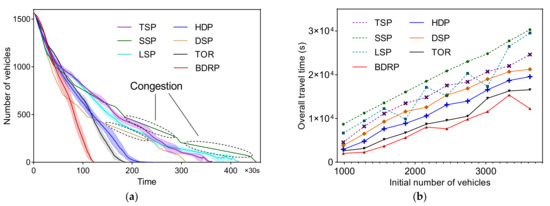
Figure 5.
Traffic efficiency comparison between different routing schemes. (a) reducing process of remaining vehicles on the road network; (b) traffic efficiency under different initial vehicle sizes.
To verify the stability and effectiveness of all methods under different initial number of vehicles, this experiment compares the vehicle travel time via 10 groups of traffic demand data with different initial number of vehicles. As shown in Figure 5b, the overall travel time of all methods presented a steady and sustained upward trend with an increase in the initial number of vehicles. Moreover, the traffic efficiency of dynamic route-planning methods is significantly better than that of static methods. Specifically, the overall travel time of the SSP method is linearly related to the initial number of vehicles, whereas the travel time of the LSP method is locally unstable. By contrast, the BDRP method presented the optimal transport efficiency in all cases.
In addition, this experiment compares the running times of these methods with different vehicle scales. A single centralized planning center node was simulated using a computer with an Intel Xeon 2.7-GHz CPU and 16-GB memory, whereas distributed computing nodes were simulated using multiple computers with Intel Core 1.0-GHz CPU and 8-GB memory. The running time of static planning methods is a single calculation time, whereas the running time of the dynamic planning method is the sum of the running time in each time step. Through a distributed planning framework, multiple computing nodes in the HDP and BDRP methods replan routes dynamically and synchronously at each time step. Thus, the running time TR of the HDP and BDRP methods is the sum of the longest running time in each time step (Equation (7)).
where is the set of elapsed times for all the computing nodes to replan routes during the i-th iteration, in which is the number of compute nodes and is the number of iterations.
As shown in Figure 6, the running time of all route-planning methods is positively correlated with the initial vehicle size. Nevertheless, route replanning within each time step causes a large gap in the computational efficiency between the dynamic and static route-planning methods. Benefitting from a single calculation, all three static planning methods can formulate routing schemes in a very short time, whereas both the TOR and DSP methods experience a large computing time cost for dynamic route planning because of their centralized planning mode (Table 2). However, the BDRP and HDP methods significantly reduce the time required for dynamic route planning through distributed computing nodes. Although the running time of the BDRP method is slightly longer than that of the HDP method, its routing scheme significantly improves the transport efficiency of the road network. Overall, the BDRP method achieves a balance between computational efficiency and routing scheme quality.
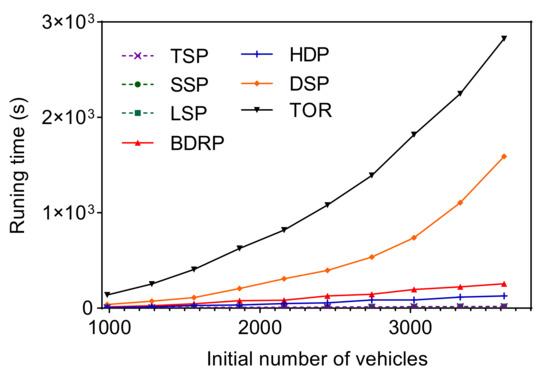
Figure 6.
Algorithm running time comparison under different initial number of vehicles.

Table 2.
Relationship between the number of vehicles and the algorithm running time (s).
4.1.3. Road Utilization Rate Comparison between Different Methods
This experiment explored the local road utilization rate change process under different route-planning methods to reveal the reasons for the difference in traffic efficiency between several route-planning schemes. The road utilization rate is defined as the ratio of the number of vehicles on a road segment and the road capacity per unit time.
where is the number of vehicles on road segment and is the road capacity of road segment per unit time.
As shown in Figure 4, intersection 6 is located at the center of the Nguyen network, which is an important convergence point of the traffic flow in the road network. The evacuation strategies of large-scale traffic flow at intersection 6 can reflect detailed differences in routing schemes. Meanwhile, in Figure 7, we detected the utilization rate change process of four road segments (Roads 7, 11, 22, and 25) that are adjacent to node 6. When congestion occurs in road segment 7, the dynamic route-planning methods would replan the routing schemes for vehicles that are scheduled to pass through the congested road segment.
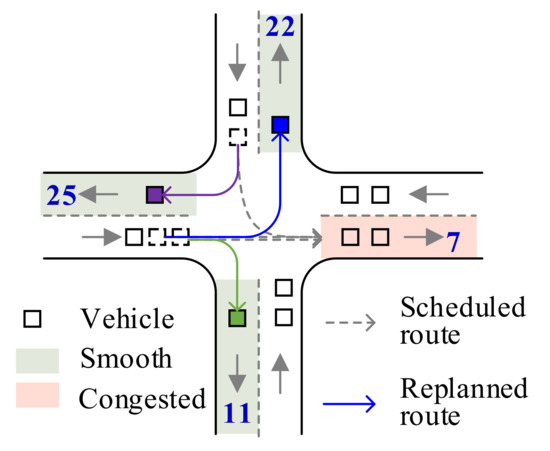
Figure 7.
Route coordination planning at intersection 6 in the Nguyen network.
The experimental result is shown in Figure 8, in which a large initial number of vehicles caused traffic congestion in road segment 7 () at the initial stage. Then, four dynamic route-planning methods quickly guided vehicles to road segments 11, 22, and 25, resulting in an increase in these sections’ utilization rate. The BDRP method coordinated multiple road segments to replan routing schemes for vehicles, which made full use of the transportation capacity of the four road segments. Thus, the vehicles converging to the congested node were rapidly evacuated (110 s). Although the HDP and TOR methods also dynamically allocated vehicles to road segments 11 and 22, the individual optimal strategy caused road segment 25 to be vacant, which prolonged the vehicle evacuation time at this congested intersection. In addition, the three static methods did not use the transportation capacity of road segments 11, 22, and 25. The long-term congestion on road segment 7 severely reduced the overall traffic efficiency of the road network.
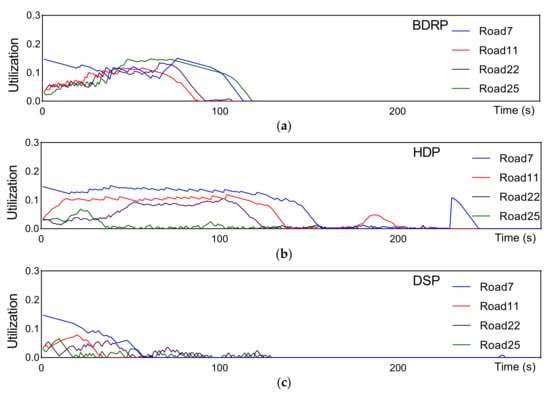
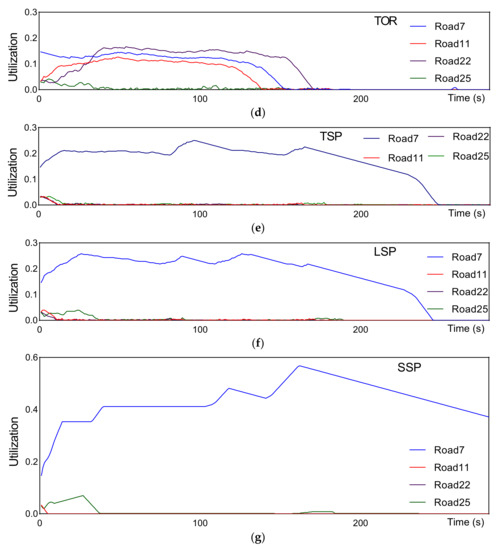
Figure 8.
Road utilization rate comparison between different road-planning methods. (a) BDRP method; (b) HDP method; (c) DSP method; (d) TOR method; (e) TSP method; (f) LSP method; (g) SSP method.
4.2. Example Application
In this experiment, the effectiveness of the BDRP method in a real urban traffic scenario was verified according to the travel records of residents in Wuhan, China. The urban traffic context and travel demand data in the study area, as well as the traffic efficiency of the routing scheme obtained by the BDRP method, are further analyzed in the following sub-sections.
4.2.1. Study Area Description
The Hankou commercial district in Wuhan, China, was selected as the research area in this experiment to verify the BDRP method in an actual road network. This commercial district is in the core area of Wuhan, where a large-scale traffic flow often causes traffic congestion. The study area contains 1596 road segments and 1062 intersections (Figure 9). In the simulation scenario of this experiment, each road segment agent has information processing and computing capabilities. The simulation parameters are listed in Table 3. Moreover, the trajectories of taxis in the Hankou district on 1 May 2014were matched to the road network in this experiment. Lastly, the original points and destinations of all trajectories were extracted as traffic demands.
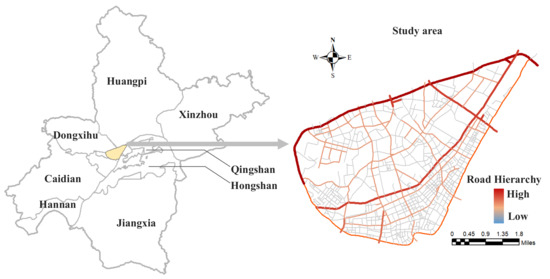
Figure 9.
Administrative divisions of Wuhan City, China, and the selected study area.

Table 3.
Parameter settings of the actual case experiment.
4.2.2. Transport Efficiency of the Road Network
The BDRP method was employed for planning dynamic vehicle routing schemes, which were analyzed spatially and temporally. From a spatial perspective, the traffic statistics results obtained by superimposing all routes into the road network are shown in Figure 10 (number of vehicles = 1400). From the figure, it is apparent that the traffic flow was significantly induced in the high-hierarchy road segments, which have greater traffic capacity and lower travel costs. Route-planning schemes effectively improve the overall traffic efficiency and people’s driving experience. Meanwhile, the traffic distribution on a low-hierarchy road network is relatively balanced, which reduces the possibility of road congestion to a certain extent.
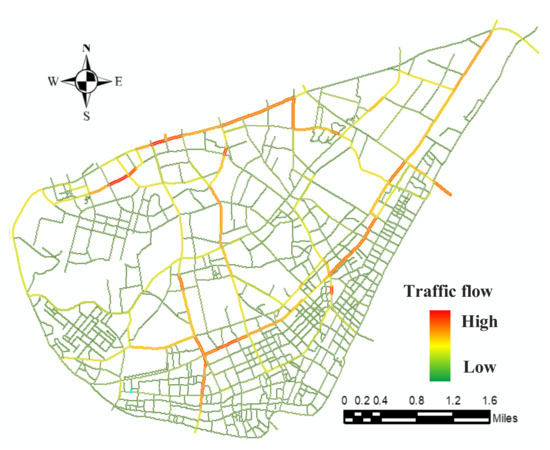
Figure 10.
Spatiotemporal pattern of routing schemes in the Hankou commercial district of Wuhan, China.
Conversely, from a temporal perspective, the remaining vehicles in the road network gradually decrease as the simulation time increases (Figure 11a). However, a small number of vehicles with longer travel distances delayed the end time of the overall travel scenario. More than 95% of vehicles reached their destinations within 50 × 30 s. In addition, there was a significant positive correlation between vehicle size and overall travel time. The overall travel time of the BDRP method increased continuously as the initial vehicle size increases. As shown in Figure 11a, when the initial number of vehicles in the road network was 600, it took 1770 s (30 × 59) to complete the travel task of all vehicles. By contrast, the overall travel time increased to 2490 s when the initial number of vehicles increased to 1400.
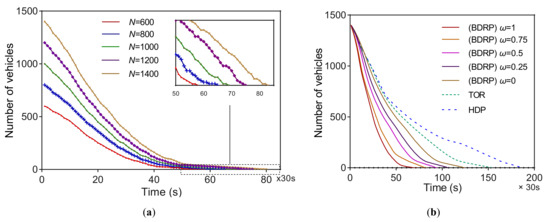
Figure 11.
Traffic efficiency under different vehicle sizes and different weight parameters. (a) route-planning efficiency under different vehicle sizes (ω = 0.5); (b) route-planning efficiency with different weights.
In simulated urban traffic scenarios, the global optimal routing scheme is usually an idealized result. In practice, drivers will weigh individual and global benefits when choosing a route [29]. To verify the performance of the proposed method in different situations, we compared the traffic efficiency under different proportions between individual optimal and global optimal conditions (Figure 11b). The results indicate that as the proportion of vehicles choosing individual optimal routes increases (ω→0), the more time the road system takes to transport all vehicles (131 × 30 s). That is, the global traffic efficiency becomes relatively lower, which is closer to that of the TOR method (155 × 30 s). Conversely, although vehicles considering global travel benefits may spend more travel time, the overall traffic efficiency of the road system improves by approximately 45% compared to the ω→0 case (72 × 30 s). Consequently, this method balances individual and system optimal route selection strategies, which indicates high performance in both cases.
The BDRP method improved the traffic efficiency of road networks by constantly adjusting the routes of vehicles affected by congestion during vehicle movement. In this experiment, the BDRP method carried out more than 3000 routes from replanning for vehicles via dynamic route planning (= 1400). A comparison of travel costs before and after each route replanning is shown in Figure 12, which shows a significant positive correlation through regression analysis. The travel cost was relatively stable in the early and middle stages of route replanning, whereas the global travel cost in the later stage of route replanning increased significantly, which means that many vehicles were close to the same destination that leads to traffic congestion. In conclusion, the travel time after route replanning is reduced by 32.71% on average, which greatly improves the traffic efficiency of the Hankou district road network.
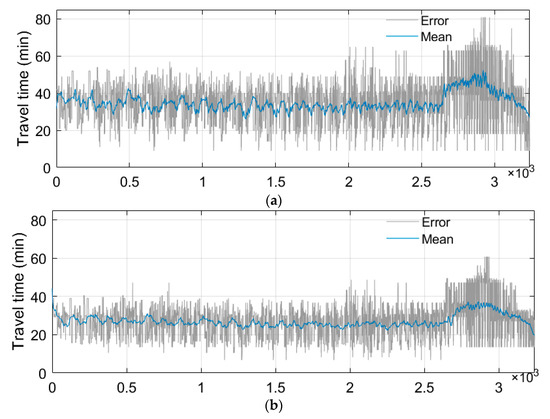
Figure 12.
Travel cost comparison (a) before and (b) after dynamic route planning.
5. Discussion
The essence of existing individual route-planning methods for CVs is to selfishly design a route with the shortest individual travel time [38], including static [13] and dynamic [38] shortest-time routes. Non-cooperative route-planning methods reduce the overall travel efficiency. In our proposed method, the bidding process, which is a multi-participant negotiation mechanism, innovatively cooperates with multiple road segment agents to formulate vehicle routing schemes based on the road intersection planning center model. The simulation and actual cases presented in the previous sections demonstrate the obvious potential of the proposed dynamic route-planning method for improving the traffic efficiency of road networks (Figure 5 and Figure 12). Compared with the individual optimal routes obtained by vehicles independently, this local negotiation method significantly improves the overall traffic efficiency of the road network, reducing the travel time by 32.71% on average. We provide a new collaborative route-planning method for CVs, that makes coordinated large-scale urban traffic flow planning in intelligent transportation scenarios possible. However, the proposed method may increase the travel cost of some individuals, which is inevitable because of the natural contradiction between individual and global optimality. Nevertheless, the costs for both individual and overall travel can be balanced by adjusting the weight parameters of the benefit function.
The empirical analysis results show that the proposed bidding model can effectively alleviate traffic congestion caused by minor contingencies (Figure 5). Furthermore, in the case of major disruptions in local areas, such as serious traffic accidents, the bidding model can still guide vehicles in congested roads to other roads to relieve the local traffic pressure. However, when major disruptions, such as extreme weather events and earthquakes, threaten the entire road network, the bidding model may not guide traffic smoothly due to the inefficiency of the entire traffic system, but it will detect an optimal route scheme under the current state to avoid continuous traffic congestion compounding as much as possible. In conclusion, the proposed model exhibits a capacity to deal with traffic congestion caused by major disruptions, and its effectiveness is largely determined by the spatial scale of such disruptions.
Moreover, the simulation case illustrates the advantages of the proposed method concerning computational efficiency (Figure 6). The road network was divided by intersections into multiple planning centers that can independently formulate routing schemes for their internal vehicles; this disperses the pressure of planning routes for large-scale traffic flow. In addition, an efficient winning bidder determination algorithm is proposed to realize a rapid selection of the final routing schemes from multiple candidates. These measures are beneficial for improving the computational efficiency of the proposed method.
6. Conclusions
In recent years, researchers involved in route-planning studies have become increasingly interested in automated vehicles [16,17] and CVs [36]. Significant progress has been made in each domain separately. However, improving the overall traffic efficiency under a vehicle interconnection scenario is still challenging. In this study, a novel bidding-based vehicle–road coordination planning method was proposed to address this challenge and to efficiently formulate route schemes that balance individual travel time and global traffic efficiency. We defined the road intersection planning center model and innovatively introduced a bidding mechanism to cooperate with road segment agents, which is observably conducive to improving traffic efficiency. Furthermore, a new local search optimization algorithm was proposed to efficiently determine the winning routing schemes in the bidding negotiation process. The case studies demonstrate the application potential of the bidding mechanism in integrating multiple distributed computing nodes. The proposed method can reduce the overall travel cost of urban transportation systems while maintaining high computational efficiency. These findings highlight the importance of improving the transport efficiency of urban road networks for alleviating urban traffic congestion and handling accidents. This study improves the global efficiency of urban transportation systems and promotes the intelligent development of urban geo-information systems. This study can also make a positive contribution to the exploration of applying autonomous vehicles in real traffic scenarios.
In future work, we will focus on route-planning strategies in hybrid travel scenarios with autonomous and human-driven vehicles and explore the disturbance of the driving route caused by the uncertainty of human travel behaviors. Optimal routing schemes are expected to have a stable output under the vehicle–infrastructure coordination architecture to cope with disturbances related to human random driving behavior.
Author Contributions
Baoju Liu proposed the idea, designed the experiments, analyzed the data, and wrote the manuscript. Supervision, Jun Long and Min Deng; writing—review and editing, Xuexi Yang and Yan Shi. All authors have read and agreed to the published version of the manuscript.
Funding
This research is supported by grants from the National Natural Science Foundation of China (42101471, 41901319, 42071452) and the Key Program of National Natural Science Foundation of China (41730105).
Institutional Review Board Statement
Not applicable.
Informed Consent Statement
Not applicable.
Data Availability Statement
Not applicable.
Acknowledgments
The authors are thankful to three anonymous reviewers for their invaluable comments and suggestions, which have improved the quality of the manuscript.
Conflicts of Interest
The authors declare no conflict of interest.
Abbreviations
The definitions of field-specific terms used in the paper.
| BDRP | bidding-based dynamic route planning |
| CV | connected vehicles |
| FIFO | first-in-first-out |
| BPR | Bureau of Public Roads |
| WDP | winner determination problem |
| PLS | priority-set-based local search |
| SSP | static shortest path method |
| TSP | top-K shortest path method |
| LSP | logit model-based shortest path method |
| HDP | hierarchical dynamic planning |
| TOR | time-optimization routing |
References
- Fan, S.; Chan-Kang, C. Regional road development, rural and urban poverty: Evidence from China. Transp. Policy 2008, 15, 305–314. [Google Scholar] [CrossRef]
- Liu, B.; Deng, M.; Yang, J.; Shi, Y.; Huang, J.; Li, C.; Qiu, B. Detecting anomalous spatial interaction patterns by maximizing urban population carrying capacity. Comput. Environ. Urban Syst. 2021, 87, 101616. [Google Scholar] [CrossRef]
- Ackaah, W. Exploring the use of advanced traffic information system to manage traffic congestion in developing countries. Sci. Afr. 2019, 4, e00079. [Google Scholar] [CrossRef]
- Sun, R.; Hu, J.; Xie, X.; Zhang, Z. Variable Speed Limit Design to Relieve Traffic Congestion based on Cooperative Vehicle Infrastructure System. Procedia Soc. Behav. Sci. 2014, 138, 427–438. [Google Scholar] [CrossRef] [Green Version]
- Liu, B.; Long, J.; Deng, M.; Tang, J.; Huang, J. Revealing spatiotemporal correlation of urban roads via traffic perturbation simulation. Sustain. Cities Soc. 2021, 103545. [Google Scholar] [CrossRef]
- Dijkstra, E.W. A note on two problems in connexion with graphs. Numer. Math. 1959, 1, 269–271. [Google Scholar] [CrossRef] [Green Version]
- Hart, P.E.; Nilsson, N.J.; Raphael, B. A Formal Basis for the Heuristic Determination of Minimum Cost Paths. IEEE Trans. Syst. Sci. Cybern. 1968, 4, 100–107. [Google Scholar] [CrossRef]
- Bellman, R. On a routing problem. Q. Appl. Math. 1958, 16, 87–90. [Google Scholar] [CrossRef] [Green Version]
- George, B.D. Linear Programming and Extensions; Princeton University Press: Princeton, NJ, USA, 1962. [Google Scholar]
- Geisberger, R.; Sanders, P.; Schultes, D.; Vetter, C. Exact Routing in Large Road Networks Using Contraction Hierarchies. Transp. Sci. 2012, 46, 388–404. [Google Scholar] [CrossRef]
- Delling, D.; Goldberg, A.V.; Razenshteyn, I.; Werneck, R.F. Graph partitioning with natural cuts. In Proceedings of the 25th International Parallel and Distributed Processing Symposium (IPDPS 2011), Anchorage, AK, USA, 16–20 May 2011; IEEE Computer Society: Washington, DC, USA, 2011; pp. 1135–1146. [Google Scholar]
- Delling, D.; Goldberg, A.V.; Werneck, R.F. Faster batched shortest paths in road networks. In Proceedings of the 11th Workshop on Algorithmic Approaches for Transportation Modeling, Optimization, and Systems (ATMOS 2011), OpenAccess Series in Informatics (OASIcs), Saarbrücken, Germany, 8 September 2011; Volume 20, pp. 52–63. [Google Scholar]
- Liu, G.; Long, W.; Wang, J.; Gao, P.; He, J.; Luo, Z.; Li, L.; Li, Y. Improving the throughput of transportation networks with a time-optimization routing strategy. Int. J. Geogr. Inf. Sci. 2018, 32, 1815–1836. [Google Scholar] [CrossRef]
- Xu, B.; Zhou, X. Dynamic relative robust shortest path problem. Comput. Ind. Eng. 2020, 148, 106651. [Google Scholar] [CrossRef]
- Xu, B.; Li, S.E.; Bian, Y.; Li, S.; Ban, X.J.; Wang, J.; Li, K. Distributed conflict-free cooperation for multiple connected vehicles at unsignalized intersections. Transp. Res. Part C Emerg. Technol. 2018, 93, 322–334. [Google Scholar] [CrossRef]
- Li, S.E.; Wang, Z.; Zheng, Y.; Sun, Q.; Gao, J.; Ma, F.; Li, K. Synchronous and asynchronous parallel computation for large-scale optimal control of connected vehicles. Transp. Res. Part C Emerg. Technol. 2020, 121, 102842. [Google Scholar] [CrossRef]
- Dai, R.; Lu, Y.; Ding, C.; Lu, G.; Wang, Y. A simulation-based approach to investigate the driver route choice behavior under the connected vehi-cle environment. Transp. Res. Part F Traffic Psychol. Behav. 2019, 65, 548–563. [Google Scholar] [CrossRef]
- Liu, Y.; Yu, Y. Distributed dynamic traffic modeling and implementation oriented different levels of induced travelers, Dis-crete Dyn. Nat. Soc. 2015, 2015, 642389. [Google Scholar]
- Zeng, W.; Miwa, T.; Wakita, Y.; Morikawa, T. Application of Lagrangian relaxation approach to α -reliable path finding in stochastic networks with correlated link travel times. Transp. Res. Part C Emerg. Technol. 2015, 56, 309–334. [Google Scholar] [CrossRef]
- Lei, F.; Wang, Y.; Lu, G.; Sun, J. A travel time reliability model of urban expressways with varying levels of service. Transp. Res. Part C Emerg. Technol. 2014, 48, 453–467. [Google Scholar] [CrossRef]
- Lee, S.; Heydecker, B.G.; Kim, J.; Park, S. Stability analysis on a dynamical model of route choice in a connected vehicle environment. Transp. Res. Procedia 2017, 23, 720–737. [Google Scholar] [CrossRef]
- Jamson, S.L.; Brouwer, R.; Seewald, P. Supporting Eco-Driving. Transp. Res. Part C Emerg. Technol. 2015, 58, 629–630. [Google Scholar] [CrossRef]
- Genders, W.; Razavi, S.N. Impact of Connected Vehicle on Work Zone Network Safety through Dynamic Route Guidance. J. Comput. Civ. Eng. 2016, 30, 04015020. [Google Scholar] [CrossRef]
- Roughgarden, T.; Tardos, É. How bad is selfish routing? JACM 2002, 49, 236–259. [Google Scholar] [CrossRef]
- Lazar, D.A.; Bıyık, E.; Sadigh, D.; Pedarsani, R. Learning how to dynamically route autonomous vehicles on shared roads. Transp. Res. Part C Emerg. Technol. 2021, 130, 103258. [Google Scholar] [CrossRef]
- Youn, H.; Gastner, M.T.; Jeong, H. Price of anarchy in transportation networks: Efficiency and opti-mality control. Phys. Rev. Lett. 2008, 101, 128701. [Google Scholar] [CrossRef] [PubMed] [Green Version]
- Yildirimoglu, M.; Ramezani, M.; Geroliminis, N. Equilibrium Analysis and Route Guidance in Large-scale Networks with MFD Dynamics. Transp. Res. Procedia 2015, 9, 185–204. [Google Scholar] [CrossRef] [Green Version]
- Shi, Y.; Wang, D.; Tang, J.; Deng, M.; Liu, H.; Liu, B. Detecting spatiotemporal extents of traffic congestion: A density-based moving object clustering approach. Int. J. Geogr. Inf. Sci. 2021, 35, 1449–1473. [Google Scholar] [CrossRef]
- Çolak, S.; Lima, A.; González, M.C. Understanding congested travel in urban areas. Nat. Commun. 2016, 7, 1–8. [Google Scholar] [CrossRef]
- Liang, L.; Yang, Y.; Wang, H.; Huang, L.; Zhang, X. Traffic Impedance Estimation Driven by Trajectories for Urban Roads. In Proceedings of the 3rd International Conference on Vision, Image and Signal Processing, Vancouver, BC, Canada, 26–28 August 2019; pp. 1–7. [Google Scholar] [CrossRef]
- Nguyen, S.; Dupuis, C. An Efficient Method for Computing Traffic Equilibria in Networks with Asymmetric Transportation Costs. Transp. Sci. 1984, 18, 185–202. [Google Scholar] [CrossRef]
- Chen, B.Y.; Lam, W.H.; Sumalee, A.; Li, Z.L. Reliable shortest path finding in stochastic networks with spatial correlated link travel times. Int. J. Geogr. Inf. Sci. 2012, 26, 365–386. [Google Scholar] [CrossRef]
- Woelki, M.; Lu, T.; Ruppe, S. Ranking of alternatives for emergency routing on urban road networks. WIT Trans. Built Environ. 2015, 146, 591–598. [Google Scholar] [CrossRef] [Green Version]
- KuKuijpers, B.; Moelans, B.; Othman, W.; Vaisman, A. Uncertainty-based map matching: The space time prism and k-shortest path algo-rithm. ISPRS Int. J. Geo Inf. 2016, 5, 204. [Google Scholar] [CrossRef] [Green Version]
- Liu, Z.; Wang, S.; Meng, Q. Toll pricing framework under logit-based stochastic user equilibrium constraints. J. Adv. Transp. 2013, 48, 1121–1137. [Google Scholar] [CrossRef] [Green Version]
- Wang, J.; Niu, H. A distributed dynamic route guidance approach based on short-term forecasts in cooperative infrastruc-ture-vehicle systems. Transp. Res. Part D Transp. Environ. 2019, 66, 23–34. [Google Scholar] [CrossRef]
- Sunita; Garg, D. Dynamizing Dijkstra: A solution to dynamic shortest path problem through retroactive priority queue. J. King Saud Univ. Comput. Inf. Sci. 2021, 33, 364–373. [Google Scholar] [CrossRef]
- Wang, P.; Deng, H.; Zhang, J.; Zhang, M. Realtime urban regional route planning model for connected vehicles based on V2X communication. J. Transp. Land Use 2020, 13, 517–538. [Google Scholar] [CrossRef]
Publisher’s Note: MDPI stays neutral with regard to jurisdictional claims in published maps and institutional affiliations. |
© 2022 by the authors. Licensee MDPI, Basel, Switzerland. This article is an open access article distributed under the terms and conditions of the Creative Commons Attribution (CC BY) license (https://creativecommons.org/licenses/by/4.0/).